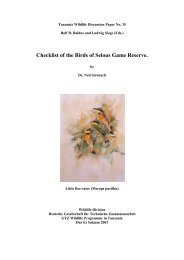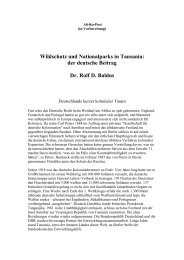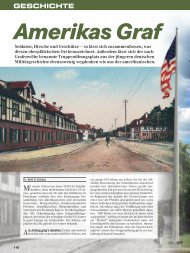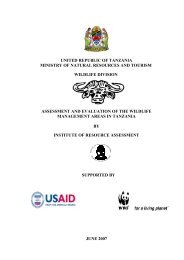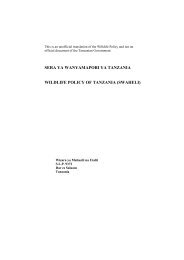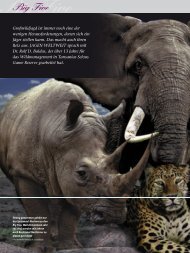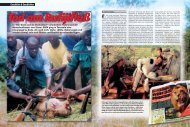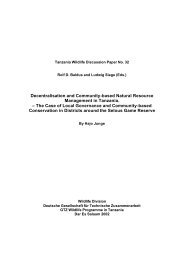African Indaba Articles - wildlife-baldus.com
African Indaba Articles - wildlife-baldus.com
African Indaba Articles - wildlife-baldus.com
You also want an ePaper? Increase the reach of your titles
YUMPU automatically turns print PDFs into web optimized ePapers that Google loves.
The Influence of Trophy Measurement in Cape BuffaloBy Winston Taylor, Environmental Biology, Oxford Brookes UniversityEditor’s Note: Winston Taylor’s scientific paper (Full Title: The Influence of Trophy Measurement on the Ageof Sport Hunted Buffalo, Syncerus Caffer (Sparrman), in the Zambezi Valley, Zimbabwe, and its Implicationsfor Sustainable Trophy Hunting,2005) has been adapted to the format of <strong>African</strong> <strong>Indaba</strong>. Due to time constraints the author could not beconsulted prior to publication, hence errors and omissions are the editor’s fault. You can download theoriginal paper from www.africanindaba.co.zaConserving <strong>wildlife</strong> in Africa is often difficult as it conflicts with humans and their activities. “One way tomake conservation gains”, particularly in the <strong>African</strong> context, “is to capitalize on the importance of wildspecies in human livelihoods”. The “sustainable harvesting of plants and hunting of animals has often turnedout to be a highly effective conservation measure” (Hutton, 2004). Sport hunting has a long and involvedhistory in Africa. The appeal of the classic “<strong>African</strong> Safari” was stimulated by the likes of Ruark andHemingway in their numerous tales of hunting and adventure in the wilds of Africa.Hunting is an important tool in conservation although it must not be seen as conservation in itself.Commercial hunting is of great value in both the economic and ecological sense. Low off-takes of trophyanimals provide good financial returns with minimal investment. Sport hunting is also a major force behindthe preservation of <strong>wildlife</strong> and wild places.The growing fragmentation of species’ habitats over the last century has led to the emergence of<strong>com</strong>munity based conservation whereby local <strong>com</strong>munities are encouraged to value <strong>wildlife</strong> through bothnon-consumptive and consumptive activities (e.g. hunting) from which they receive multiple benefits. Prior tothese new “radical” ways of tackling conservation, much of colonial Africa was subject to state-centric“fortress conservation”, in which rural <strong>African</strong>s were seen as the enemy of conservation and degraders of theenvironment. Community conservation on the other hand encourages, through the concept of “sustainabledevelopment”, that species, habitats and biodiversity, should be seen as exploitable and managed throughconservation and developmental goals.Villagers are given a share in license fees paid by wealthy clients and suddenly see a species, such asbuffalo or elephant, not as a menacing crop raider but as a highly valuable asset which should be protected.Clients will also be charged a range of fees by the government, collected either directly or on thegovernment’s behalf by the safari operator. Such fees are likely to include a conservation fee, firearms andammunition permit fees, trophy export fees, airport fees etc. It is through such systems that hunting can beused as a tool in conservation. However, if hunting is to be pursued in areas where <strong>wildlife</strong> resources arefinite, a tight management regime has to be employed in order to ensure its sustainability. Incorrectmanagement of the hunted <strong>wildlife</strong> would result in unstable population dynamics, diminished gene pools andultimately loss of species from an area.The <strong>African</strong> Cape buffalo, Syncerus caffer, is one of the classic <strong>African</strong> trophies, and consequently a keyspecies in safari hunting. In Zimbabwe (total hunting earnings 1998: US$23 million) it is the second mostimportant species, in monetary terms. Sport hunting is where the future of the Cape buffalo lies especiallyoutside of formally protected areas.Buffalo are classed as one of the “Big 5”. The very nature of buffalo make them a desirable trophy, if notthe ultimate big game trophy for the hunting sportsperson. They are unpredictable and thus difficult anddangerous to get close to, hence the hunters’ skills are tested to the full and the true characteristics of a hunt– fear, fascination and adrenaline - are evoked.Maintaining a high market value for buffalo hunting relies upon the provision of quality trophies, achievedthrough the implementation of trophy quota systems. Offtakes need to be carefully regulated and withinbiological limits. Buffalo populations typically grow at about 7% p a; however, in order to ensure qualitytrophies offtakes should be limited to 2% p a.It is of concern that immature buffalo are being over hunted because of the <strong>com</strong>bined effect of high offtakequotas, and the possible influence of inappropriate measurement systems. There are currently two119



